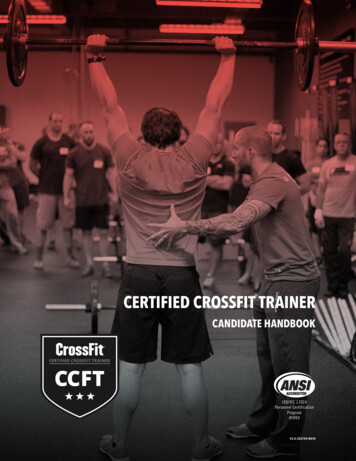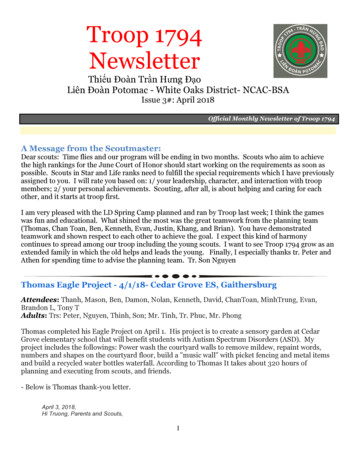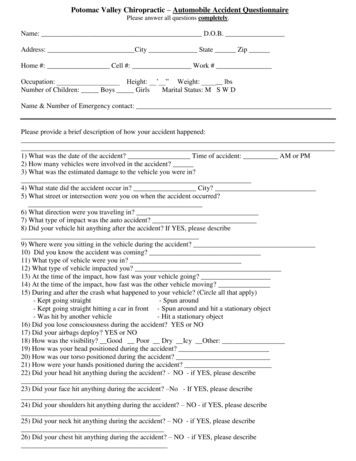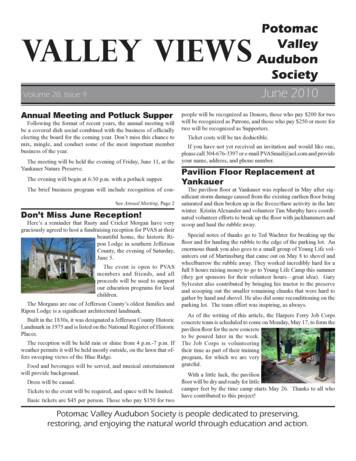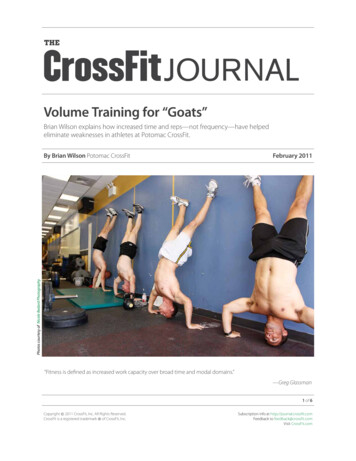
Transcription
THEJOURNALVolume Training for “Goats”Brian Wilson explains how increased time and reps—not frequency—have helpedeliminate weaknesses in athletes at Potomac CrossFit.February 2011Photos courtesy of Nicole Bedard PhotographyBy Brian Wilson Potomac CrossFit“Fitness is defined as increased work capacity over broad time and modal domains.”—Greg Glassman1 of 6Copyright 2011 CrossFit, Inc. All Rights Reserved.CrossFit is a registered trademark of CrossFit, Inc.Subscription info at http://journal.crossfit.comFeedback to feedback@crossfit.comVisit CrossFit.com
Volume .(continued)Much has been said about muscular endurance, modalcapacity and training weaknesses in CrossFit. What I’d liketo cover here is just one tool that might help athletes andcoaches quickly improve a distinct weakness.This training technique—called volume training—hasbeen used in various forms; it is characterized by specificand repetitive training for a weakness.It could be fielding ground balls with a backhandtechnique in baseball, shooting free throws in basketball,or pressing to handstand in gymnastics. The goal is todevelop proprioception and endurance—defined as theability to reproduce a movement many times over or atlength—in that specific modal capacity.The inspiration for this method came from my time in theMarine Corps and is a bastardized version of the Recon RonPull-Up Program, which the Marines have used for years toprepare prospective officer candidate school enrollees forthe pull-up portion of their physical-fitness test. Volumetraining is similar to the Recon Ron Pull-Up Program butincreases time and reps while decreasing frequency oftraining.This training method isdesigned to allow the athleteto practice the movementwith near-perfect form, not tocreate a significant metabolicconditioning response.Volume training can be performed for any humanmovement, but at Potomac CrossFit we have found thatupper-body gymnastics movements (e.g., handstandpush-ups, pull-ups, ring dips, push-ups, muscle-ups) seethe greatest relative improvement with this method.However, any uncommon movement or modal weaknesscan be improved with volume training, including frontlevers, back levers, planches, pistols, double-unders, GHDsit-ups, rope climbs, etc.Camille Leblanc-Bazinet’s outstanding performances in themuscle-up/snatch WOD and handstand push-up/clean WODduring the 2010 Games gave her a huge bump in the standings.A key concept to remember is the athlete should workat a sub-maximal effort. This training method is designedto allow the athlete to practice the movement with nearperfect form, not to create a significant metabolic-conditioning response.By working on modalities in which the CrossFit athleteis weak, we can improve those to a degree that whenreintroduced in a traditional CrossFit WOD, he or she willgenerate an improvement in metabolic capacity becausethe athlete can repeat the movement many times, andquickly, without reaching complete muscular failure.I believe this principle is critical to understanding CrossFitprogramming in general and the reasoning behindvolume training specifically.2 of 6Copyright 2011 CrossFit, Inc. All Rights Reserved.CrossFit is a registered trademark of CrossFit, Inc.Subscription info at http://journal.crossfit.comFeedback to feedback@crossfit.comVisit CrossFit.com
Volume .(continued)Programming Volume TrainingThere are infinite varieties of time, reps and modal domainsone can use volume training to improve. First, let us look ata common weakness among CrossFitters: the handstandpush-up. We will look at a baseline template to improvethat weakness and ways to measure progress and results.As a general rule, Potomac CrossFit prescribes 20-minutevolume-training sessions twice per week for the averageCrossFit athlete, with reps performed every minute on theminute. The goal is to work sub-maximally (not reachingmuscle failure) and maintain a difference of no more than2 reps from the first set to the last set.A typical progression from the first to the fifth session forhandstand push-ups can be seen in Table 1 below.The athlete’s goal is to continue to progress in total numberof reps completed per session, while still not going beyond2 in the difference between Minute 1 and Minute 20.As the athlete progresses,our trainers have foundthat making the movementmore difficult trumpsadditional reps.For athletes with above-average recovery abilities, PotomacCrossFit has added one extra volume-training session perweek. Again, pay attention to how the athlete is recoveringand how the sessions match up with the athlete’s otherworkouts.At Potomac CrossFit, we have found the greatest benefitfrom volume training is after a strength workout. Ifperformed on the same day as a met-con, volume trainingshould be done before the main workout, with carefulattention paid to the total reps performed that are pushes,pulls, etc.Volume training should be prescribed for athletes whohave trained regularly for several months or years but stillhave one or two modalities that need improvement. Whilethis plan might be of use for beginners, we have found theofficial CrossFit Warm-Up to be best for beginners.It’s important to have athletes test their single-set max ofwhatever movement(s) you will focus on. However, youand the athlete will be able to determine progress quicklyfrom session to session, as shown below.As the athlete progresses, our trainers have found thatmaking the movement more difficult trumps additionalreps. Timing will vary depending on the athlete.Qualitatively, we determine if the athlete is now capablewithin the modal capacity. If so, we next want the athleteto become dominant.For CrossFit Games athletes, the importance of not onlyhaving no weaknesses but being strong in the movementsthat many are weak in has been a key to success each year.Examples of the transition from capable to dominant are: Handstand push-ups on parallettes or rings. Weighted ring dips. Weighted muscle-ups. Weighted pull-ups.On the other end of the spectrum, we can use volumetraining for athletes who don’t have their first rep. For thiswe first use isometric and then eccentric movementsMinute12345678910 11 12 13 14 15 16 17 18 19 22222222243Reps3333333333332222222250Table 1: A five-session volume-training log for handstand push-ups.3 of 6Copyright 2011 CrossFit, Inc. All Rights Reserved.CrossFit is a registered trademark of CrossFit, Inc.Subscription info at http://journal.crossfit.comFeedback to feedback@crossfit.comVisit CrossFit.com
Volume .(continued)within the volume-training template. An athlete whocannot perform a pull-up would use a flexed-arm hang of3-10 seconds per minute and then progress to 1-3 pull-upnegatives until achieving the first pull-up. Then the athletewould use a mix of pull-ups and pull-up negatives duringthe sessions.Take care not to overtrain eccentric movements! Doing socan increase the risk of rhabdomyolysis for a newer athlete(or even an experienced athlete who is new to this trainingmethodology).(For additional info about minimizing the risk of rhabdo,please read The Truth About Rhabdo by Dr. Mike Ray,published Jan. 4, 2010, in the CrossFit Journal.)Time and BenefitsWhile the idea of shortening or lengthening these sessionsmakes sense to us based on our observations, the adage“if ain’t broke, don’t fix it” has been our guiding precept. Sowe’ve stuck with the 20-minute sessions.Volume training has worked wonders for our athletes,including a lot of folks with significant “goats” that we’veotherwise been unable to fix.We would love feedback from the CrossFit communitywith respect to tweaks on this model.Some of our athletes have tried to incorporate twodeficiencies within one volume-training session, andwe’ve seen both successes and failures within that model.There also is a significantpsychological benefitin volume training.Athletes do not, as a generalrule, want to work on whatthey are bad at. But showthem quick progress andthey’ll be itching to get backto the gym to get another rep,and another.We’ve found that combining upper-body and lowerbody movements does not seem to diminish progresswithin the template. So combinations such as handstandpush-ups and box jumps, pull-ups and pistols, and ringdips and kettlebell swings have worked fine.However, combining two upper-body movements seemsto diminish progress in both movements. The guidancewe give: stick to one movement most of the time. If youwant to do an upper-body/lower-body volume-trainingcouplet, that’s fine. Just make sure you still are seeingprogress in your top-priority movement(s).Rich Froning Jr.’s significant lead going into the last event at the2010 Games was erased by his lack of ability in the rope climb.4 of 6Copyright 2011 CrossFit, Inc. All Rights Reserved.CrossFit is a registered trademark of CrossFit, Inc.Subscription info at http://journal.crossfit.comFeedback to feedback@crossfit.comVisit CrossFit.com
Volume .(continued)Benefits of volume training for a coach or box: Easy to scale to individuals, so it can be performed aspart of a warm-up or “cash out.”While these athletes saw some progress, several thingsheld them up: I did a bad job of clearly showing the athlete heor she was improving, which the volume-trainingformat does. I was cycling through too many movements in anattempt to keep it interesting rather than focusingon weaknesses. Significant rest each minute means athletes cancycle through equipment or space. Can be done in a group setting or individually. Easy to measure improvement. Progress is what yourclients pay you for! Easy to supervise while other activities are going onin the gym.Their bodies were spending significant amounts onthe healing process, limiting their ability to buildstrength, coordination, etc.The important theme to remember here is the idea ofbuilding modal capacity vs. improving conditioning.As a result, I had a significant number of injured athletesstop training with me.“One consequence of a warm-up like this is that biggernumbers of pull-ups, push-ups, sit-ups, and other calisthenic movements will ensue. Before anyone gets 25pull-ups, three sets of 10 will have to be a breeze,” GregGlassman wrote.The CrossFit Warm-Up is a wonderful tool to build modalcapacity in gymnastics movements. However, nearlyevery athlete we have trained has had some issue thatjust doesn’t seem to get better. If we see continued stasisin one or more modalities while others improve, shiftingour focus to improve those capacities is what’s requiredif the athlete wants to improve both modal capacity andconditioning.There also is a significant psychological benefit in volumetraining. Athletes do not, as a general rule, want to work onwhat they are bad at. But show them quick progress, evenif it’s just one more rep than they did the last session, andthey’ll be itching to get back to the gym to get anotherrep, and another.Surprising Side EffectsAt Potomac CrossFit, we had an unexpected benefitof incorporating volume training into some of ourprogramming. Since the time we opened, we’ve hadathletes who have been injured (most of them outside thegym, with the majority of them injured through joggingand golf ). I was responsible for giving these athletesonline programming and had them come into the gymwhen they could to perform the WODs I had programmedspecifically for them.Athletes dealing with injuries are some of the bestcandidates for volume training.5 of 6Copyright 2011 CrossFit, Inc. All Rights Reserved.CrossFit is a registered trademark of CrossFit, Inc.Subscription info at http://journal.crossfit.comFeedback to feedback@crossfit.comVisit CrossFit.com
Volume .(continued)But once my fellow coaches and I read the CrossFit Journal’sWorking Wounded article through the lens of volumetraining and implemented a program built around it, wesaw significant progress in athletes’ modal abilities andexcitement about training again even while severely injured.By seeing significant gains in gymnastic movements eachweek, athletes are energized and excited about the trainingthey can do instead of disappointed about not being ableto participate in the WOD. Most of them want to stay in theWorking Wounded class longer then necessary becausethey want to be able to crush their non-injured fellowathletes in upper-body gymnastics movements.“The greatest improvementin your overall fitness willcome from going headlongat your weaknesses.”A significant number of athletes continue to makeprogress on their “goats” by simply hitting movementsfrequently enough to make progress, but not so frequentlythat they get overuse injuries. However, either psychologically or physically, there is a large swath of athletes whoneed tools to make measurable progress on their “goats,”improve their fitness and stick with a fitness program.—Greg GlassmanI hope volume training can be that tool for your box.We now have a significant number of athletes who notonly are surviving injuries (stress fractures, severely pulledhamstrings, bulging discs, labrum tears, broken wrists)but are also thriving within our “Working Wounded” class,which we offer three times per week.During these classes we do a warm-up, barbell/dumbbellmax effort and volume training. A typical series of classesfor an athlete with one usable leg is:Day 13-3-3-3-3 seated dumbbell pressesRing-dip volume trainingFAbout the AuthorBrian Wilson is a captain in the U.S.Marine Corps Reserve. He holds amechanical-engineering degreefrom the U.S. Naval Academy andis a student at St. John’s CollegeGraduate Institute in Annapolis, Md.He is co-owner of Potomac CrossFit.He doesn’t have a Facebook account,and his favorite movie is Fletch.Day 2:3-3-3-3-3 suitcase deadliftsPistol volume trainingDay 3:3-3-3-3-3 bench pressesPull-up volume training6 of 6Copyright 2011 CrossFit, Inc. All Rights Reserved.CrossFit is a registered trademark of C
the pull-up portion of their physical-fitness test. Volume training is similar to the Recon Ron Pull-Up Program but increases time and reps while decreasing frequency of training. Volume training can be performed for any human movement, but at Potomac CrossFit we have found that upper-body gymnastics movements (e.g., handstand push-ups, pull-ups, ring dips, push-ups, muscle-ups) see the .
